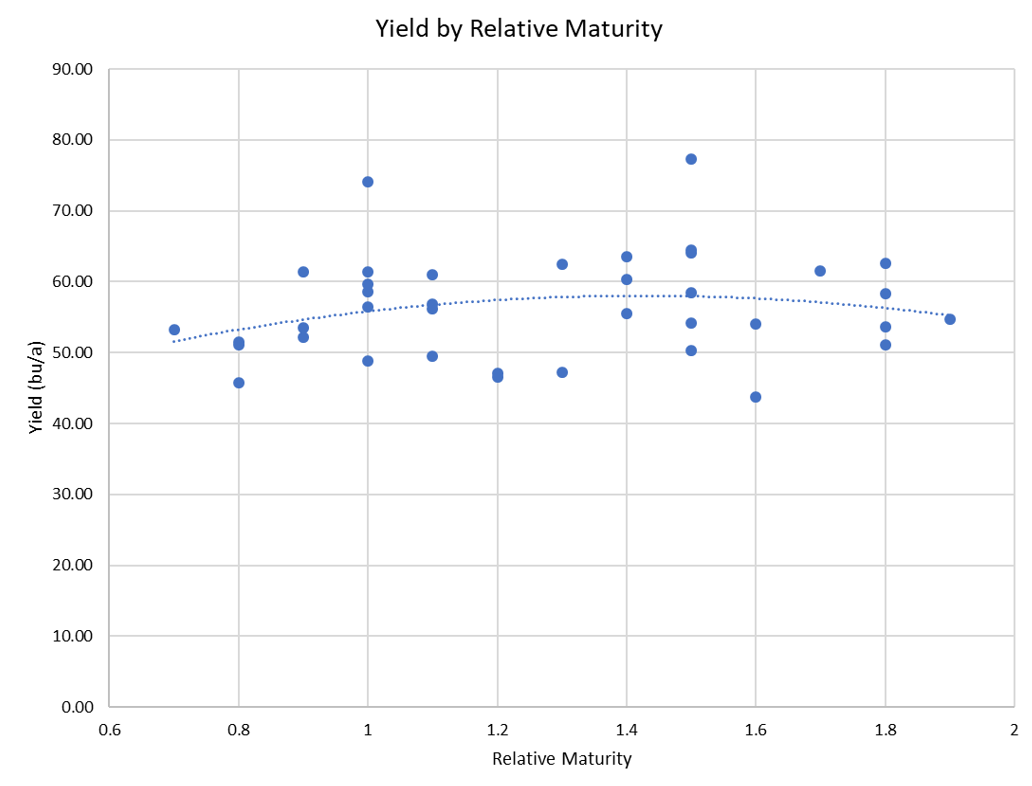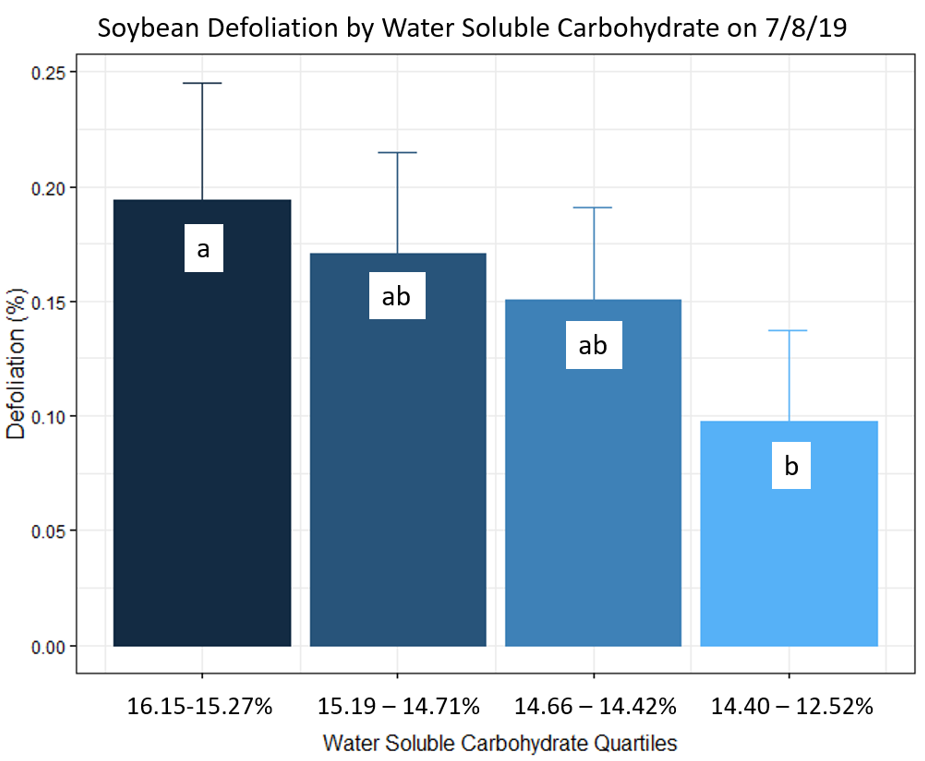Results of early maturity soybean variety trials in northern Michigan
MSU soybean variety trials identified adapted maturity ranges, high yielding varieties and factors driving white-tailed deer preference in northern Michigan.

In 2019, Michigan State University Extension received funding from the Michigan Soybean Promotion Committee to evaluate early maturing soybean varieties at two sites, one in northeast Lower Michigan and one in the Upper Peninsula. Public variety performance information for extra-early maturity groups (RM 0.00-1.20) has previously not been available in Michigan. Our objective was to inform farmers in northern Michigan about the performance of soybean varieties adapted to local conditions. This included yield potential of individual varieties as well as gathering additional information on variety phenology and susceptibility to white-tailed deer damage.
Thirty-nine soybean varieties were planted in Hillman, Michigan, on May 24, 2019 and in Escanaba, Michigan, on June 3, 2019 (170,000 seeds per acre). Plots were 4 feet by 16 feet with 7-inch row spacing. Boarders and alleys were planted to minimize edge effect. Two plots were planted at each location, one open to deer damage and the other fenced in to minimize deer damage. Weekly observations of phenology and deer browse were made to identify differences between brands, varieties and maturity groups.
At both locations, 200 pounds per acre of 0-14-42 was applied at planting. At the Hillman location, 4 ounces per acre of Raptor was applied as a postemergence herbicide. At the Escanaba location, 4 ounces per acre of Raptor, 1 quart of Basagran and 16 ounces of Select was applied as a postemergence herbicide.
Growing degree day (GDD) accumulation from planting to harvest at the Hillman location was 1,752 GDD base 50, which was slightly below normal, and rainfall was 3 inches above the six-year average. Growing degree day accumulation from planting to harvest at Escanaba was 1,680 GDD base 50, which was near normal. Rainfall was 7 inches above the six-year average at the Escanaba location, yet abnormally dry drought conditions occurred mid-September compromising grain fill.
Soybeans were harvested Oct. 25 in Hillman and Oct. 31 in Escanaba using a Winterstieger plot combine. Weight, moisture and test weight of harvested grain was recorded, and reported yields were corrected to the standard moisture content of 13%.
Maturity and yield results
The Hillman trial averaged 56.51 bushels per acre with the lowest yielding variety producing 43.71 bushels per acre and the best performing variety yielding 77.27 bushels per acre (Table 1). The 10-year Montmorency County average soybean yield is 36 bushels per acre, according to the USDA’s National Agricultural Statistics Service.
The Escanaba trial averaged 47.54 bushels per acre with the lowest yielding variety producing 32.12 bushels per acre and the best performing variety yielding 59.28 bushels per acre (Table 2). The average soybean yield for Delta and Menominee counties is 41.0 bushels per acre, according to the USDA’s National Agricultural Statistics Service.
|
Table 1. Soybean yield in the Hillman trial by brand and relative maturity. (* Denotes varieties that yielded similarly to the highest yielding variety at alpha = 0.05. ** Denotes the highest yielding variety overall) | |||||||||
|---|---|---|---|---|---|---|---|---|---|
|
Brand |
Variety |
Maturity group |
Yield (bu/ac) |
Sig. |
Brand |
Variety |
Maturity group |
Yield (bu/ac) |
Sig. |
|
Asgrow |
AG14X8 |
1.4 |
55.44 |
* |
Legacy Seeds |
LS 1039N |
1 |
48.77 |
|
|
Asgrow |
AG11X8 |
1.1 |
56.19 |
* |
Legacy Seeds |
LS1019 |
1 |
58.60 |
* |
|
Asgrow |
AG10X9 |
1 |
59.70 |
* |
LG Seeds |
C2580RX |
2.5 |
NA** |
|
|
Asgrow |
AG09X9 |
0.9 |
53.56 |
* |
LG Seeds |
C1414Rx |
1.4 |
63.49 |
* |
|
Asgrow |
AG08X0 |
0.8 |
51.46 |
* |
LG Seeds |
C1000RX |
1 |
74.09 |
* |
|
Dairyland |
DSR-1673E |
1.6 |
43.71 |
MSU |
E13268 |
1.5 |
64.49 |
* |
|
|
Dairyland |
DSR-0847E |
0.8 |
45.77 |
MSU |
E15338 |
1.5 |
64.11 |
* |
|
|
Dairyland |
DSR-0717E |
0.7 |
53.26 |
* |
MSU |
E16099 |
1.5 |
77.27 |
** |
|
DF Seeds |
DF187 |
1.8 |
58.28 |
* |
MSU |
E18834 |
1.5 |
50.25 |
* |
|
DF Seeds |
DF3180NE3 |
1.8 |
53.59 |
* |
Pioneer |
P19A14X |
1.9 |
54.70 |
* |
|
DF Seeds |
DF6189NLLGT27 |
1.8 |
62.55 |
* |
Pioneer |
P16A13X |
1.6 |
54.10 |
* |
|
Federal Hybrids |
F1109NLLGT+ |
1.1 |
61.45 |
* |
Pioneer |
P11A44X |
1.1 |
56.91 |
* |
|
Federal Hybrids |
F106NRR2Y |
1 |
52.18 |
* |
Pioneer |
P09A53X |
0.9 |
61.44 |
* |
|
Federal Hybrids |
FO99ONR2X |
0.9 |
49.46 |
* |
Wolf River Valley |
WRV 3015 GTLL |
1.5 |
54.20 |
* |
|
Golden Harvest |
GH1538X |
1.5 |
58.47 |
* |
Wolf River Valley |
WRV 3012 GTLL |
1.2 |
46.56 |
|
|
Golden Harvest |
GH1317X |
1.3 |
62.39 |
* |
Wolf River Valley |
WRV 2808RR |
0.8 |
51.14 |
* |
|
Golden Harvest |
GH1024X |
1 |
56.50 |
* |
ZFS |
e17Y993 |
1.7 |
61.47 |
* |
|
Legacy Seeds |
LS1838N |
1.8 |
51.06 |
* |
ZFS |
e13H988 |
1.3 |
47.25 |
|
|
Legacy Seeds |
LS1439N |
1.4 |
60.27 |
* |
ZFS |
e12H902 |
1.2 |
47.14 |
|
|
Legacy Seeds |
LS1138N |
1.1 |
61.03 |
* |
Average |
|
1.3 |
56.51 |
|
|
**Yield for the LG variety C2580RX is not reported due to seed contamination. |
|||||||||
|
Table 2. Soybean yield in the Escanaba trial by brand and relative maturity. (* Denotes varieties that yielded similarly to the highest yielding variety at alpha = 0.05.** Denotes the highest yielding variety overall) | |||||||||
|---|---|---|---|---|---|---|---|---|---|
|
Brand |
Variety |
Maturity group |
Yield (bu/ac) |
Sig. |
Brand |
Variety |
Maturity group |
Yield (bu/ac) |
Sig. |
|
Asgrow |
AG14X8 |
1.4 |
57.18 |
* |
Legacy Seeds |
LS1019 |
1.0 |
52.12 |
* |
|
Asgrow |
AG11X8 |
1.1 |
46.89 |
* |
Legacy Seeds |
LS 1039N |
1.0 |
48.51 |
* |
|
Asgrow |
AG10X9 |
1.0 |
50.86 |
* |
LG Seeds |
C2580RX |
2.5 |
NA** |
|
|
Asgrow |
AG09X9 |
0.9 |
50.14 |
* |
LG Seeds |
C1414Rx |
1.4 |
55.60 |
* |
|
Asgrow |
AG08X0 |
0.8 |
32.12 |
LG Seeds |
C1000RX |
1.0 |
44.89 |
* |
|
|
Dairyland |
DSR-1673E |
1.6 |
44.14 |
* |
MSU |
E18834 |
1.8 |
33.81 |
|
|
Dairyland |
DSR-0847E |
0.8 |
48.68 |
* |
MSU |
E16099 |
1.6 |
51.88 |
* |
|
Dairyland |
DSR-0717E |
0.7 |
44.87 |
* |
MSU |
E15338 |
1.5 |
46.54 |
* |
|
DF Seeds |
DF3180NE3 |
1.8 |
55.80 |
* |
MSU |
E13268 |
1.3 |
49.20 |
* |
|
DF Seeds |
DF6189NLLGT27 |
1.8 |
51.08 |
* |
Pioneer |
P19A14X |
1.9 |
59.28 |
** |
|
DF Seeds |
DF187 |
1.8 |
46.44 |
* |
Pioneer |
P16A13X |
1.6 |
42.36 |
* |
|
Federal Hybrids |
F1109NLLGT+ |
1.1 |
55.24 |
* |
Pioneer |
P11A44X |
1.1 |
51.06 |
* |
|
Federal Hybrids |
F106NRR2Y |
1.0 |
43.72 |
* |
Pioneer |
P09A53X |
0.9 |
55.04 |
* |
|
Federal Hybrids |
FO99ONR2X |
0.9 |
46.81 |
* |
Wolf River Valley |
WRV 3015 GTLL |
1.5 |
44.79 |
* |
|
Golden Harvest |
GH1538X |
1.5 |
48.47 |
* |
Wolf River Valley |
WRV 3012 GTLL |
1.2 |
41.40 |
* |
|
Golden Harvest |
GH1317X |
1.3 |
44.85 |
* |
Wolf River Valley |
WRV 2808RR |
0.8 |
50.62 |
* |
|
Golden Harvest |
GH1024X |
1.0 |
41.93 |
* |
ZFS |
e17Y993 |
1.7 |
44.60 |
* |
|
Legacy Seeds |
LS1838N |
1.8 |
38.58 |
* |
ZFS |
e13H988 |
1.3 |
38.98 |
* |
|
Legacy Seeds |
LS1439N |
1.4 |
48.51 |
* |
ZFS |
e12H902 |
1.2 |
43.90 |
* |
|
Legacy Seeds |
LS1138N |
1.1 |
52.27 |
* |
Average |
|
1.3 |
47.54 |
|
|
**Yield for the LG variety C2580RX is not reported due to seed contamination |
|||||||||
We also sought to understand the interaction of relative maturity and soybean yield potential in northern Michigan. Analyzing the data this way revealed no significant difference in yield across maturity groups 0.7-1.9 in 2019 for the Hillman location (Fig. 1). In 2018, the earliest maturity groups (RM < 0.8) yielded significantly less than later maturity groups at Hillman (P=0.002). This year’s trial did not include varieties earlier than RM 0.7 to allow for a direct comparison across years. However, based on two years of data, soybeans of RM 0.8-1.9 appear to be equally well adapted to northeast Michigan.

At the Escanaba location, there were also no significant differences in yield between maturity groups in 2019. However, some varieties with RM >1.7 did not mature before frost in the last two years of Upper Peninsula trials. Based on our two years of data, soybeans of RM 0.7-1.7 appear to be well adapted to the southern Upper Peninsula. We recommend northern Michigan growers plant multiple soybean varieties within these respective ranges to mitigate weather and agronomic risk.
White-tailed deer feeding results
The interaction of soybean forage quality and white-tailed deer feeding was also investigated in 2019. This was accomplished by comparing deer damage in the field to forage quality of soybean leaves analyzed by Dairyland Labs. Of 15 forage quality parameters measured, only water-soluble carbohydrates (sugar) was correlated with soybean defoliation (Fig. 2). Water-soluble carbohydrates was positively correlated with mean variety defoliation rated on July 3 and 8, 2019. This finding is similar to our 2018 results showing a negative correlation between starch (versus simple sugars) in corn silage hybrids and black bear damage.

Without replication of forage quality data within varieties, we were not able to identify significant differences in water soluble carbohydrates by variety. Water-soluble carbohydrates was not correlated with soybean yield in this study, suggesting that it could be used for deer depredation resistant soybeans. However, deer may still damage low water-soluble carbohydrates soybean varieties, depending on factors such as deer density and the availability of alternative food sources.
Special acknowledgement to the staff at the MSU Upper Peninsula Research and Extension Center for their work on this trial, including Christian Kapp and Andy Bahrman. For questions related to this research project, please contact Christian Tollini at tollinic@msu.edu.



 Print
Print Email
Email




